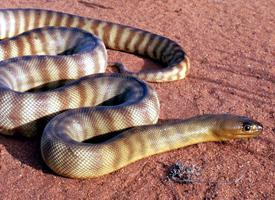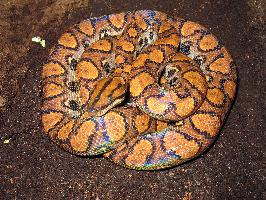
Súlyok és méretek
| Hossz | 180-tól 250-ig cm |
|---|
Állatleírás
The Woma python (Aspidites ramsayi), also known as Ramsay's python, is a remarkable species of snake native to Australia. This fascinating creature is not only known for its unique appearance but also for its interesting behavior and ecological role within its natural habitat. As a member of the family Pythonidae, it is a non-venomous constrictor, relying on its strength rather than venom to subdue prey.Physical Description
Adult Woma pythons typically reach lengths of about 1.5 to 2.5 meters, although some individuals can grow slightly larger. They possess a slender, muscular body that is perfectly adapted for their burrowing lifestyle. Their coloration is an intriguing aspect of their appearance, featuring a pattern of bands or blotches that range from yellowish-tan to a rich, earthy brown. This pattern provides excellent camouflage against the sandy and rocky soils of their natural habitat. One of the most distinctive features of the Woma python is its head, which is narrow and slightly distinct from the neck. Their small, symmetrical scales give them a smooth texture, and their eyes, with vertical pupils, add to their distinctive look.
Habitat and Distribution
Woma pythons are endemic to Australia and are found across a wide range of habitats, from the arid deserts and scrublands of the interior to the edges of forests in more temperate regions. They are particularly adept at surviving in harsh, arid environments, where they spend much of their time sheltering in burrows to escape the extreme daytime heat.
Behavior and Ecology
Woma pythons are nocturnal hunters, coming out at night to seek prey. Their diet is varied, including a range of small to medium-sized mammals, birds, and occasionally reptiles, which they locate using their heat-sensitive pits located near the mouth, an adaptation shared by many pythons. Once they have secured their prey, they employ constriction to suffocate it before consumption.
One of the most interesting aspects of Woma python behavior is their method of hunting. Unlike many other snakes, Woma pythons can use a portion of their body to 'plug' burrows, trapping prey inside. This technique showcases their adaptability and intelligence as hunters.
Reproduction in Woma pythons is oviparous, meaning they lay eggs. Females will lay a clutch of eggs, which they then incubate by coiling around them and generating heat through muscular contractions, a process known as shivering thermogenesis. This dedication ensures the eggs are kept at a constant, optimal temperature until they hatch.
Conservation Status
The Woma python is currently listed as Least Concern by the International Union for Conservation of Nature (IUCN), although its populations are believed to be declining. Habitat destruction, especially due to agricultural development and mining, poses a significant threat to their survival. Additionally, they are sometimes killed on roads or by feral animals. Conservation efforts are focused on habitat protection and raising awareness about the species to mitigate these threats.
Cultural and Human Interest
Woma pythons have a certain allure in the pet trade due to their docile nature and unique appearance. However, prospective owners should be aware of the specific care requirements and ecological implications of keeping such a species. In Aboriginal cultures, the Woma python holds significance in various mythologies and is respected as part of the natural world.
In conclusion, the Woma python is a captivating species that embodies the diversity and adaptability of Australia's reptile fauna. Its survival is closely tied to the health of its environment, making it a symbol of the challenges facing the natural world today. Conservation efforts and increased awareness are vital to ensuring that future generations can continue to marvel at this unique and beautiful creature.
Hasonló állatok
Új állatfotók
Top 10 állat
- Dolphin gull (Leucophaeus scoresbii)
- Diana monkey (Cercopithecus diana)
- Moustached guenon (Cercopithecus cephus)
- Galápagos tortoise (Geochelone nigra complex)
- Stone loach (Barbatula barbatula)
- Japanese macaque (Macaca fuscata)
- Greek tortoise (Testudo graeca)
- Russian tortoise (Testudo horsfieldii)
- Common flying dragon (Draco volans)
- Galápagos penguin (Spheniscus mendiculus)


